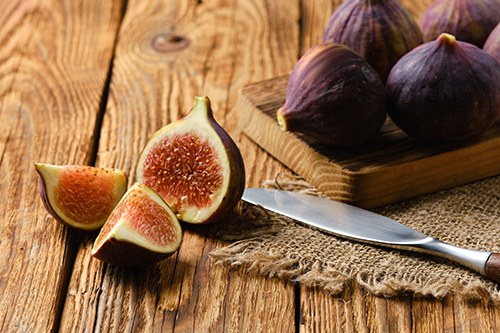Contents
For centuries, the Greeks have known about the many medicinal and health benefits of figs. Following Galen’s recommendations, classical Greek athletes ate figs to restore their strength. Today, the health benefits of figs still play a significant role in the diets of rural Greece, Italy, Portugal, and Spain.
Turkish stevedores, famous for their strength, included figs in their diets when mechanical aids were not readily available. This is probably the genesis of the well-known phrase “He’s as strong as a Turk.” In addition to muscular strength, figs provide many other healing properties that make them particularly healthful fruits.

Medicinal and Health Benefits of Figs
Carbohydrates are the most significant component in figs, composing 15.9 percent by weight. Most of these are monosaccharides, simple sugars (fructose and glucose), and a small portion of disaccharides (saccharose). Their proportion of proteins does not reach one percent, and their fat content is only 0.3 percent.
Figs are rich in vitamins E, B6, B1, and B2. Conversely, they are deficient in vitamins A and C. Their more prominent minerals are potassium, calcium, magnesium, and iron. Figs contain zinc, copper, and manganese, trace elements in significant quantities.
Figs are easily digested and have an emollient (soothing) effect on the bronchial passages and the digestive tract. Figs are also laxative and diuretic. Regular consumption of this food is beneficial in the following cases:

Bronchial disorders – Figs, regardless of how they are prepared, particularly dried figs rehydrated or boiled with milk, have a pectoral action that fights infections. They help alleviate cough, aid expectoration, and soothe the respiratory tract. Their use is recommended in chronic bronchitis cases and acute respiratory infections caused by colds or flu.
Constipation – Fresh and rehydrated dried figs are beneficial in cases of slow intestinal peristaltic. They perform just like prunes. They soothe the digestive tract and stimulate peristaltic in the intestine, thus moving feces.
Increase in nutritional need—Figs in any form are a highly desirable food in cases of anemia or fatigue from physiological or psychological causes because of their stimulating effect. Pregnant or lactating women, adolescents, and all involved in physical (athletes) or psychological (students) activities will find figs highly nutritious, easily digested, and high-energy food.
Figs are also used externally for skin disorders, as described in more detail here!
Figs Scientific Facts

- Scientific Name – Ficus carica L.
- Other Names – Common fig, Poor-man’s-food.
- French – Figue.
- Spanish – Higo, breva.
- German – Feige.
- Description – The sweet, fleshy, hollow, pear-shaped, multiple fruits of the fig tree, a deciduous plant, has numerous tiny seedlike fruits. It is of the botanical family Moraceae. Certain fig trees give two crops yearly; spring’s early figs are very tender and juicy. Later, figs are harvested in late summer or fall.
- Environment—Figs are from hot, semiarid Mediterranean regions. Spanish explorers introduced them to the American continent, and they acclimated very well to the West Coast of North America. Turkey, Greece, Portugal, Spain, and California are the primary producers.
How to Prepare and Use Figs
- Fresh – Figs must be tree-ripened to enjoy their sweetness and flavor truly. If they are harvested green, they will never fully ripen. Fresh figs are only available in the market for a few weeks a year because they are difficult to transport and store.
- Dried – Dried figs have lost two-thirds of their water content, which highly concentrates their sugars, vitamins, and minerals. They are available year-round. Soaking them overnight rehydrates them before eating.
- Boiled in milk (preferably non-dairy) – A half dozen dried figs cooked in half-liter milk is an excellent cough remedy and expectorant, mainly if a few spoonfuls of honey are added.
- Fig cakes – These are prepared from dried figs, almonds, and aromatic herbs. They provide a great deal of energy and are refreshing to the whole body.
DISCLAIMER: All content on this website is presented solely for educational and informational objectives. Do not rely on the information provided as a replacement for advice, diagnosis, or treatment from a qualified medical expert. If you are pregnant, nursing, or have any preexisting medical concerns, talk to your doctor before using any herbal or natural medicines.
REFERENCES
- George D. Pamplona-Roger, M.D. “Encyclopedia of Foods and Their Healing Power.” George D. Pamplona-Roger, M.D. Encyclopedia of Foods and Their Healing Power. Trans. Annette Melgosa. Vol. 2. Chai Wan: Editorial Safeliz, 2005. 145, 146. Print. [Health benefits of figs]
- Health.com https://www.health.com/health-benefits-of-figs-7571179
- WebMD https://www.webmd.com/diet/health-benefits-figs
